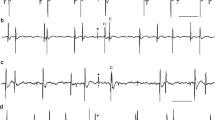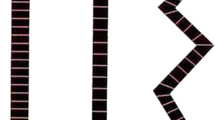Summary
-
1.
This report extends the work of Lundberg and Winsbury (1960a and 1960b) in emphasizing the usefulness of brief muscle stretch for selective activation of the primary endings of muscle spindles.
-
2.
In 36 experiments on anesthetized cats a distribution of rhomboid stretch (20 msec duration) thresholds was obtained for activation of 393 stretch receptors from de-efferented soleus muscles maintained at comparable degrees of initial tension by setting length to give a peak of active tension during an isometric twitch. These receptors included 153 Ia afferents with conduction velocities greater than 75 m/sec, 127 Ib afferents and 97 group II afferents with conduction velocities below 65 m/sec. A pull of 60 μ or less activated 95% of the Ia fibers in contrast to 41% of the group II fibers and only 3% of the Ib fibers. At threshold the mean latency (normalized) between the onset of stretch and impulse arrival at the spinal cord (recording electrodes) was 5.4 msec for the Ia fibers (S.D.±1.7 msec), 10.6 (± 3.9) msec for the group II fibers, and 9.1 (± 3.3) msec for the Ib afferents. In all cases only one impulse was initiated by the test stretch and no significant differences were encountered in the responses of receptors located in proximal, middle and distal portions of the muscle.
-
3.
In 7 experiments soleus nerve volleys were recorded at nerve-muscle and spinal cord-dorsal root levels during similar stretching procedures. A stretch of 5 μ amplitude was sufficient to generate a group I volley. As stretch amplitude was raised to 60 μ this volley grew progressively in size and decreased in duration as well as in latency from stretch onset to volley formation. A second volley, 1.5 to 2.0 msec after the first, developed with a 30 μ stretch. At 60 μ stretch its size was approximately 30–50% that of the first volley. Conduction velocity for the first volley was 90–110 m/sec and was faster than the second volley by 5–10 m/sec. Our data on isolated afferents suggest that the first volley is of Ia origin while the second volley represents predominantly a second discharge from some Ia afferents plus a minor group II input. Significant Ib contribution is excluded since only 4 of the 127 Ib fibers responded within this stretch range and then at latencies beyond formation of either volley.
Similar content being viewed by others
References
Bessou, P., Laporte, Y.: Responses from primary and secondary endings of the same neuromuscular spindle of the tenuissimus muscle of the cat. In: Symposium on Muscle Receptors, pp. 105–119. Ed. by D. Barker. Hong Kong: Hong Kong University Press 1962.
Bianconi, R., Van der Meulen, J.P.: The response to vibration of the end organs of mammalian muscle spindles. J. Neurophysiol. 26, 177–190 (1963).
Bradley, L., Eccles, J.C.: Analysis of the fast afferent impulses from thigh muscles. J. Physiol. (Lond.) 122, 462–473 (1953).
Brown, M.C., Engberg, I., Matthews, P.B.C.: The relative sensitivity to vibration of muscle receptors of the cat. J. Physiol. (Lond.) 192, 773–800 (1967).
Brown, M.C., Lawrence, D.G., Matthews, P.B.C.: Reflex inhibition by Ia afferent input of spontaneously discharging motoneurones in the decerebrate cat. J. Physiol. (Lond.) 198, 5P-7P (1968).
Buller, A.J., Eccles, J.C., Eccles, R.M.: Differentiation of fast and slow muscles in the cat hind limb. J. Physiol. (Lond.) 150, 399–416 (1960).
Coppin, C.M.L., Jack, J.J.B., McIntyre, A.K.: Properties of group I afferent fibers from semitendinosus muscle in the cat. J. Physiol. (Lond.) 203, 45P-46P (1969).
Eccles, J.C.: Central connexions of muscle afferent fibers. In: Symposium on Muscle Receptors, pp. 81–101. Ed. by D. Barker. Hong Kong: Hong Kong University Press 1962.
—, Eccles, R.M., Lundberg, A.: The convergence of monosynaptic excitatory afferents on to many different species of alpha motoneurones. J. Physiol. (Lond.) 137, 22–50 (1957).
Eccles, R.M., Lundberg, A.: Integrative pattern of Ia synaptic actions on motoneurones of hip and knee muscles. J. Physiol. (Lond.) 144, 271–298 (1958).
Hunt, C.C.: Relation of function to diameter in afferent fibers of muscle nerves. J. gen. Physiol. 38, 117–131 (1954).
—, McIntyre, A.K.: Characteristics of responses from receptors from the flexor longus digitorum muscle and the adjoining interosseous region of the cat. J. Physiol. (Lond.) 153, 74–87 (1960).
—, Perl, E.R.: Spinal reflex mechanisms concerned with skeletal muscle. Physiol. Rev. 40, 538–579 (1960).
Laporte, Y., Bessou, P.: Étude des sous-groupes lent et rapide du Groupe I (fibres afférentes d'origine musculaire de grand diamètre) chezle chat. J. Physiol. (Paris) 49, 1025–1037 (1957).
Lennerstrand, G.: Position and velocity sensitivity of muscle spindles in the cat. I. Primary and secondary endings deprived of fusimotor activation. Acta physiol. scand. 73, 281–299 (1968).
—, Thoden, V.: Dynamic analysis of muscle spindle endings in the cat using length changes of different length-time relations. Acta physiol. scand. 73, 234–250 (1968).
Lloyd, D.P.C.: Spinal mechanisms involved in somatic activities. In: Handbook of Physiology. I. Neurophysiology, Sect. I, Vol. II, pp. 929–949. Ed. by J. Field. Washington: Amer. Physiol. Soc. 1960.
—, Chang, H.-T.: Afferent fibers in muscle nerves. J. Neurophysiol. 11, 199–207 (1948).
—, Mclntyre, A.K.: Dorsal column conduction of Group I muscle afferent impulses and their relay through Clarke's column. J. Neurophysiol. 13, 39–54 (1950).
Lundberg, A., Winsbury, G.: Selective adequate activation of large afferents from muscle spindles and Golgi tendon organs. Acta physiol. scand. 49, 155–164 (1960a).
—: Functional organization of the dorsal spino-cerebellar tract. VI. Further experiments on excitation from tendon organ and muscle spindle afferents. Acta physiol. scand. 49, 165–170 (1960b).
Matthews, P.B.C.: Vibration and the stretch reflex. In: Myotatic, Kinesthetic and Vestibular Mechanisms, pp. 40–50. Ed. by A.V.S. de Reuck and J. Knight. Boston: Little, Brown and Co. 1967.
—: Evidence that the secondary as well as the primary endings of muscle may be responsible for the tonic stretch reflex in the decerebrate cat. J. Physiol. (Lond.) 204, 365–393 (1969).
—, Stein, R.B.: The sensitivity of muscle spindle afferents to small changes in length. J. Physiol. (Lond.) 200, 723–743 (1969).
Mosher, C.G., Stuart, D.G., Gerlach, R.L., Reinking, R.M.: Muscle receptor responses to transient stretches. Trans. Amer, neurol. Ass. (in press) (1969a).
—: Selective activation of Ia volleys by transient muscle stretch. Physiologist 12, 309 (1969b).
Shugarman, M., de Santis, M., Eldred, E.: Group I muscle afferent nerve conduction velocities for hindlimb muscles of the cat, rabbit and dog. Anat. Rec. 163, 263–264 (1969).
Stuart, D.G., Mosher, C.G., Gerlach, R.L., Reinking, R.M.: Selective activation of Ia afferents by transient muscle stretch. Fed. Proc. 28, 783 (1969).
Author information
Authors and Affiliations
Rights and permissions
About this article
Cite this article
Stuart, D.G., Mosher, C.G., Gerlach, R.L. et al. Selective activation of Ia afferents by transient muscle stretch. Exp Brain Res 10, 477–487 (1970). https://doi.org/10.1007/BF00234264
Received:
Issue Date:
DOI: https://doi.org/10.1007/BF00234264




